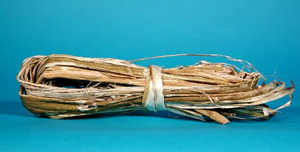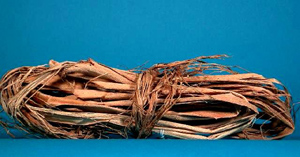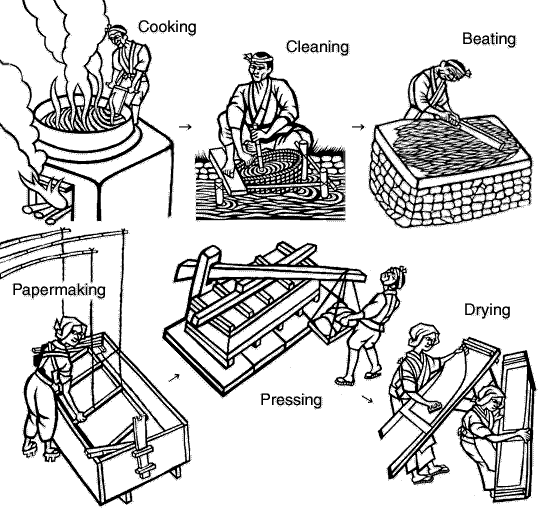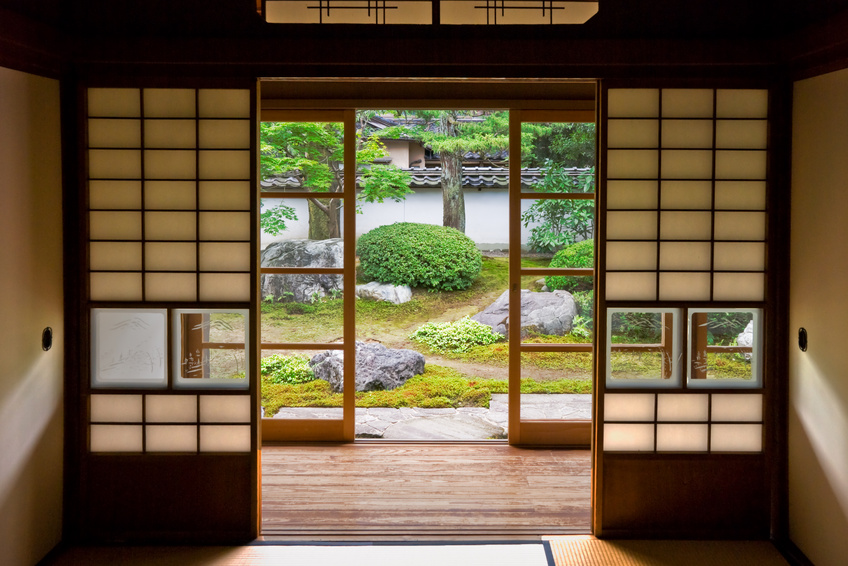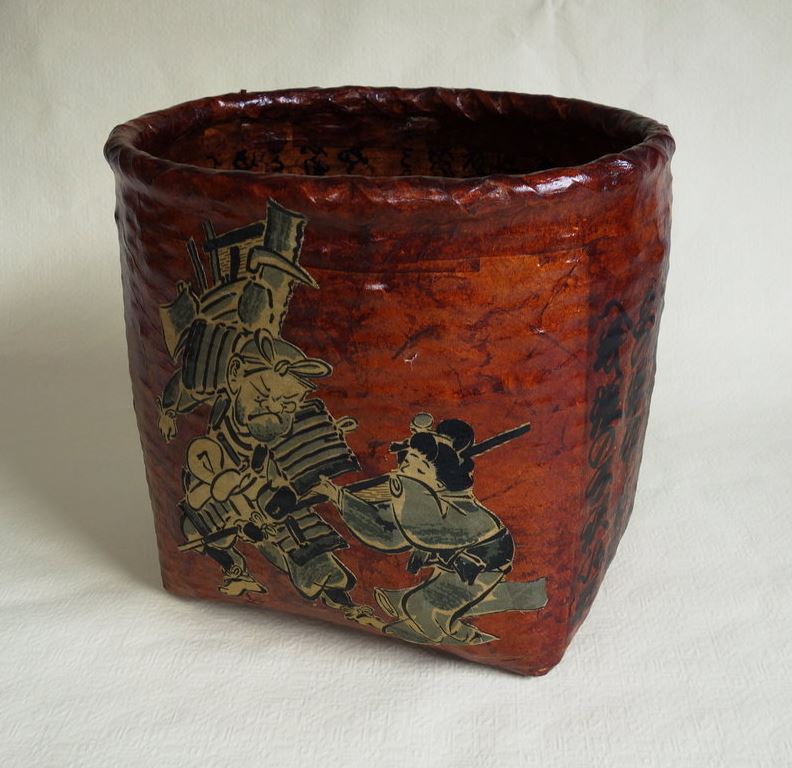The Japanese have a long history of papermaking techniques that have survived over the centuries. Washi, which literally means ancient Japan (和 wa) and paper (紙 shi), not only has many practical uses but is also well-known for its strength and beauty. From printing to clothing to architecture, it has a special place in Japanese culture. In fact, In 2014, Washi was declared as one of UNESCO’s Intangible Cultural Heritage Objects.
Raw Materials
Washi is commonly made from Kōzo, Gampi and Mitsumata.
Kōzo (楮, Broussonetia kazinoki x B. papyrifera)
Kōzo is a low growth decidious tree of the mulberry family and at full growth the branches reach over 3 meters a year. It is easily cultivated in either wet or dry fields. And takes 2-3 years before the plant is mature enough for papermaking. Stems are harvested between December and January. Kōzo bark consists of the outermost layer kurokawa (黒皮, meaning black bark), the middle layer amakawa (甘皮, meaning epidermis), which is greenish colour, and the inner layer shirokawa (白皮, meaning white bark). For the best quality paper, only the inner white layer is used. The fiber is thick, long and strong so it is appropriate for making products such as shoji sliding doors. Well-known areas for kōzo cultivation are Ibaraki and Kōchi Prefectures.
Gampi (雁皮, Wilstroemia sikokiana)
Gampi is harvested in the spring when the plants are saturated with water and sap. It thrives in the wild and is commonly cultivated on hillsides. It has very strong fibers and must be harvested from February to May. Gampi produces paper that is durable, naturally water resistant and insect repellent. This shiny paper has a distinct crackling sound when handled. Because superior quality gampi fibers are rare, this type of paper is very expensive and is often used as calligraphy paper or in the pounding of gold leaf.
Mitsumata (三椏, Edgeworthia chrysantha)
Mitsumata is a low growth decidious tree of the daphne family. Its branches can reach a height of over 2 meters. This material was originally brought from China in the later Muromachi period (1337–1573) but it was not the Edo period (1603–1868) when the material became common for papermaking. Mitsumata creates fibers that are soft, absorbent, and resistant to pests. Its fibers are quite short and forms a sponge-like pattern. It is usually manufactured with other fibers although unadulterated mitsumata produces very fine writing paper. This is also the type of paper used for Japanese bank notes.
Paper making Process
Peeling
The outer layer of the stem is removed until only the white middle part remains.
Bleaching
The stem is soaked in water in special water baths so it will soften . In ancient times, the kōzo branch is steeped in the river for 2-3 days.
Boiling
The fibers are removed by boiling them for 2 hours in large vats filled with baking soda.
Removing dust
Any remaining dark particles are taken out by hand while immersed in cold water.
Beating
The kōzo fibers are pounded thoroughly with a wooden mallet placed on a stone slab.
Kamisuki (Paper-making)
The sticky liquid extracted from the root of Tororoaoi called “nebeshi” is blended with the kozo pulp in a contraption called a sukibune. The fluid inside the sukibune is mixed and scooped using a tool called the suketa.
Compression
The paper produced is then stacked and pressed for a full day to remove any excess moisture.
Drying
After the sheets are pressed they are they placed on a board and sun dried.
Sorting
The sheets are then evaluated by holding it to a light source to check for any rips, tears or impurities. The thickness is also examined.
Cutting
The chosen sheets of paper are cut into the preferred size and shape using a special knife.
What Makes Washi Paper Special
Strength
High quality washi was so strong and durable that historically it was used for armour and kimono-lining.
Soft Translucency
Washi is naturally translucent and are used in productd that require light to pass through.
Absorbency
Washi fibers are able to easily absorb inks and dyes. If the paper is pure, it will create more vibrant colors.
Flexibility
It is resistant to creasing, wrinkling and tearing and thus exhibit quality that is similar to cloth.
Lightweight
Washi weighs much less than other types of paper with similar thickness.
Low acidity
Traditionally-made Japanese paper is free from acids since they not bleached. Thus we can find archival paper that is a millennia old that is still in perfect condition.
Examples of Washi in Japanese Culture
Kamiko
The Japanese have made durable clothes made from Washi paper. This craftmanship reached its height during the Edo Period (1603-1868). Washi clothing can be as soft as cotton but a lot less expensive. It is often coated with persimmon tannin or konnyaku (devil’s tongue) paste to make it tougher and water resistant. Kamiko textiles and those made from paper yarns known as shifu were commonly made into work wear, kimonos and sleeping clothes.
Shoji Dividers
A shoji screen is a translucent folding screen that is commonly used as a room divider. It is designed using a wood frame that is covered with paper or cloth in a specific sequence through a technique known as karibari. Washi is the ideal material to manufacture these dividers because it is lightweight, heat retentive, breathable and translucent. Shoji screens can also refer to permanent structures like shoji doors and shoji windows which feature the same construction. Traditionally, shoji screens were used as decorative displays that showed myths and legends pertaining to Japanese history.
Ikkanbari
Ikkanbari are lacquered items created from twisted woven paper strings (koyori). It is a kind of papier-mâché technique, in which washi paper is pasted on wooden or bamboo frames then coated with persimmon tannin. The resulting product is very strong, durable and water resistant. Most common items made from this technique are boxes, trays, bowls and various containers.
Follow us on Facebook to get updated on latest Japanese lessons and articles about Japanese culture. We also have free lessons on our renewed website, LearnJapanese123.com
Get your original Hanko (Name seal) @ https://japanese-name-stamp.com



